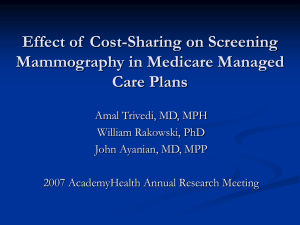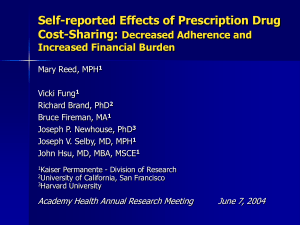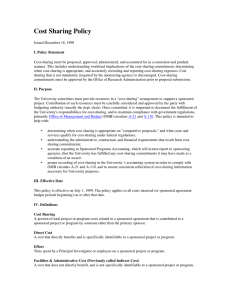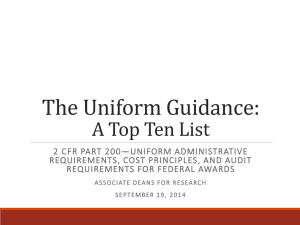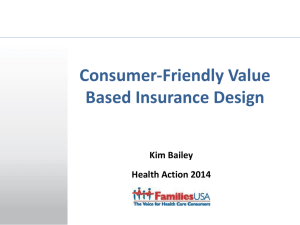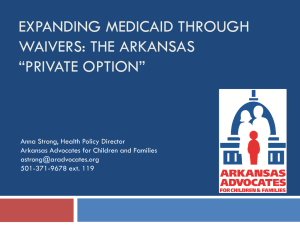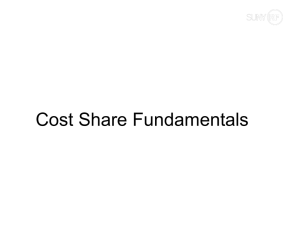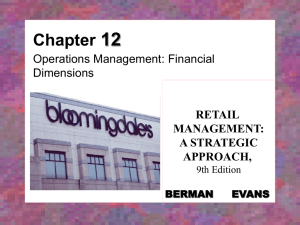Accounting for Cost Share: Post Award and Beyond
advertisement
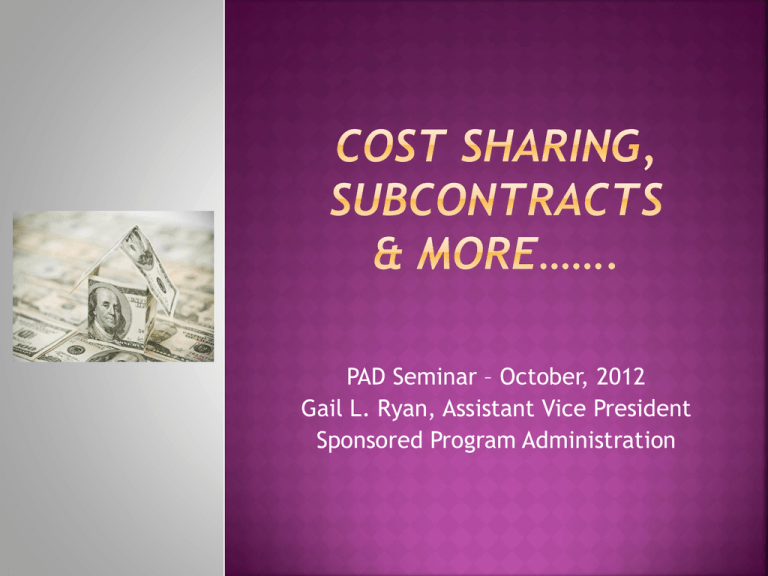
PAD Seminar – October, 2012 Gail L. Ryan, Assistant Vice President Sponsored Program Administration High level understanding of the following: Cost-sharing on sponsored projects Sub-contracts on sponsored projects OMB Circular A-21 Basics Uses of Indirect Cost Recovery Definition (reference OMB Circular A-110): Project costs not borne by the sponsor but supported by contributions from the recipient and/or third parties, both cash and in-kind. Portion of research costs that are not borne by the sponsor Primarily required by federal sponsors Pledge can be a % of total project costs or a fixed amount Obligation must come from non federal funds Obligation must not come from federal flow through Mandatory – explicit in award document and/or explicit in program announcement or guidelines. Voluntary Committed – defined and quantified in either dollars or narrative in proposal. Voluntary Uncommitted – occurs in course of project, was not planned or anticipated. Cost overruns fall into this category Committed Regardless of mandatory or voluntary, once committed becomes true obligation to the institution. Must be documented in financial system Proposal commitments = Award requirements Voluntary cost-sharing Uncommitted cost-sharing Treated differently than committed cost-sharing. Not included in organized research base for F&A rate purposes. Excluded from effort reporting requirements of A-21, Section J-8. Does NOT need to be documented Personnel – time/effort of PI or other staff Per OMB A-110, rates for volunteer services shall be consistent with those paid for similar work in the recipient’s organization. Equipment – sometimes a required match for a new piece of equipment to be provided by the University. Use of existing equipment is usually not allowable as cost-sharing. Operational costs – supplies, travel, etc. “In-kind” cost sharing – donations by third parties. Quantifiable Certification/documentation of actual F&A – reduction in recovery can often be claimed PI will spend 20% effort for the project at no cost to the agency PI will be available to provide advice As opposed to PI will use general budget to purchase the $500K laser interferometer PI has access to laser interferometer How should salary amount in excess of the agency (e.g. NIH) salary cap be handled? Salary cap is considered voluntary committed, and must therefore be documented and identifiable within the financial records of the institution. Current NIH salary cap = $179,700 Dr. Smith’s salary is $250,000/year Proposed effort on project -10% = $25,000/yr Max to be charged to grant is $17,970 17,970 = 7.188% = ~7% 250,000 Charge 7% to project and 3% to cost-sharing Cost-sharing requirements may be passed along to sub-recipients. Prime awardee retains ultimate responsibility for the commitment. Therefore, if sub-recipient does not meet their match requirement, the prime awardee may need to scramble at the end of the project. Important to monitor as part of invoicing approval process, etc. In order to be claimed as c/s, must meet all the same criteria to be allowable on the award: Incurred during award period Allowable expenditure to the project Necessary and reasonable for accomplishing project goals and objectives Must be auditable Items normally treated as indirect costs (e.g. office supplies, clerical salaries, etc.) Specifically Cost unallowable costs sharing used on another project Funding sources should be identified at the time of proposal submission to ensure that commitments are in place. In other words, “don’t put it in the proposal if you aren’t willing and able to cover the cost!” Some agencies may require c/s expenditures to occur at same pace as sponsored award. Consider total cost to the institution – hidden costs of c/s include: Loss of fringe benefits and indirect cost recovery Increase in research base for F&A calculations Staff time at both departmental and central level for accounting and reporting of c/s Cash – those outlays that involve an actual outlay of cash by the institution (personnel, supplies, equipment, etc.) In-kind – non-cash contributions provided by non-federal third parties, e.g. Volunteer services Donated supplies/equipment – must use current fair market value Either type must be identifiable and able to be documented. There are several “not so obvious” negative impacts of voluntary cost-sharing. Negative impacts: Lowers F&A rate Complicates effort reporting system Increases administrative costs for tracking/reporting cost-share If there is no documentation (i.e. in the payroll distribution system) of the time devoted to research, an agency may factor in additional dollars into the research base. This may hurt your rate negotiation process! Better to be able to bury them in documentation. Basics of the F&A rate: Pooled expenditures – those that cannot be allocated to a particular project (i.e. indirect costs) Base expenditures – those direct expenses that make up an institution’s MTDC base Rate = Pool Base Goal is to keep the pool high and the base low. Where does cost-sharing fit in? Indirect Expenses (pooled costs) = 100,000 MTDC Base = 200,000 Rate = 100,000 = 50% 200,000 Add 20,000 of cost sharing expenses to base. Indirect Expenses (pooled costs) = 100,000 MTDC Base = 220,000 Rate = 100,000 = 45.45% 220,000 Only commit to cost-sharing when required. Only commit to the level of the amount required. Only commit what you are prepared to deliver. DOCUMENT, DOCUMENT, DOCUMENT! Differentiation between a subcontractor and a vendor is the first step: Subcontract: An agreement written under the authority of and consistent with the terms of the Prime Award (grant or contract) that transfers a portion of the research or substantive effort to another organization. A subcontract is normally signed by both parties. Personal Services Contract: A written agreement that transfers a specialized service not available through a routine service provider. The contractor requires a specialized knowledge in a particular field and often requires originality, creativity, and decisionmaking abilities. The agreement is intellectual and professional in nature, and is normally signed by both parties. Purchased Services: Are orders to procure goods and services that are normally routine in nature. They are normally signed only by the Purchasing party. A subcontract is an appropriate procurement mechanism when: 1. The collaboration is substantive programmatic work which is beyond mere analytical work-forhire normally conducted by a routine service provider. 2. The collaboration is substantial enough that the collaborating individual or organization will participate in preparation of results, publication, presentation or other collaborative participation beyond routine analytical work. 3. The collaborator will maintain control of the work to be performed under the subcontract. Subcontracts are typically identified in the proposal and/or approved by the sponsor. SPA has a team dedicated to preparation and administration of subcontracts. Approval of invoices from subrecipients is a shared responsibility: PI responsible for verifying work proceeding at an expected pace, and expenses are reasonable based on work completed. SPA responsible for verifying budget, allowability of expenses, etc. Approve scope of work and related budget Ensure receipt of required deliverables and/or progress reports and review for appropriateness Align deliverables/progress reports with invoices submitted for payment Coordinate any modifications with the SPA contracts team (e.g. change in scope, rebudget request, etc.) Federal awards – OMB Circular A21 outlines allowability for certain types of expenditures. A21 = “Cost Principles for Educational Institutions” Guidance on what should be direct charged to projects vs. what we recover via our indirect cost rate Specifically, costs of a clerical or administrative nature are considered “sensitive” and care must be taken if direct charged (typically recovered via indirects) The following items are considered sensitive, and require extra justification to directly charge to federal projects: Clerical and administrative salaries Office supplies (includes computers by definition of equipment threshold) Telephone line costs (local) Postage Other Certain criteria need to be met in order to allow these types of expenses as direct charges: Must be able to identify the costs specifically to the project with a high degree of accuracy Costs must be incurred for a different purpose or circumstance (how the item is used, not “what it is”) OR part of a “major project” as defined in the circular. Costs must have been explicitly budgeted, with justification, and awarded. ICR funds are set up in the general fund range, and must follow the “rules” for the general fund. Typical expenditures include items necessary to the research, but which might be considered questionable, or unallowable, if charged directly to a sponsored project. Examples of expenditures include: Office supplies, toner, computers, etc. (those items which we discussed as being A21 sensitive) Travel Memberships, dues Books, journals Miscellaneous items which are not easily identifiable to a particular project (e.g. shared by multiple projects)

